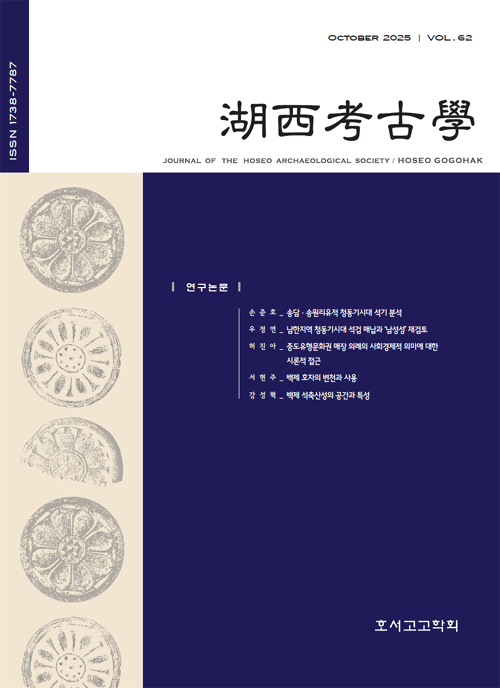- 영문명
- Change and use of Hoja(urinal) of Baekje
- 발행기관
- 호서고고학회
- 저자명
- 서현주(Hyunju Seo)
- 간행물 정보
- 『호서고고학』62집, 86~116쪽, 전체 31쪽
- 주제분류
- 인문학 > 역사학
- 파일형태
- 발행일자
- 2025.10.30
6,520원
구매일시로부터 72시간 이내에 다운로드 가능합니다.
이 학술논문 정보는 (주)교보문고와 각 발행기관 사이에 저작물 이용 계약이 체결된 것으로, 교보문고를 통해 제공되고 있습니다.

국문 초록
한반도 삼국시대 호자는 백제 유물이 가장 많고 형태도 다양하다. 본고에서는 백제 호자의 출토 현황을 정리하고, 중국과 고구려 호자를 검토하면서 호자를 분류한 후 이를 바탕으로 백제 호자의 계통, 변천 양상을 살펴보았다. 그리고 호자의 형식별 분포 백제에서 다양한 형식의 호자가 나타난 요인도 파악해보았다.
현재까지 확인된 백제 호자는 40여 점이다. 이를 중국, 고구려 호자와 함께 분류하여 조형(鳥形), 수형(獸形, 伏虎形·坐虎形 포함), 병형(甁形)으로 나누고, 다시 13개의 형식으로 분류하였다. 이 중 백제에서는 중국 청자를 포함하여 복호 A2형과 B형, 좌호 A1형과 A2형, B형, 병 A형과 Bb형, 조Bb형 등 8개 형식이 확인된다. 한성기에는 복호A2형(청자)과 복호B형 호자만 소수 확인되며, 주로 중국계 사람들이 사용한 것으로 보인다. 웅진기 자료는 확실하지 않다. 사비기에는 다양한 형식의 호자가 확인되어, 중국과 마찬가지로 남성용 소변기로서의 호자 사용 문화가 도성과 중요 지방의 상위계층에 확산된 것으로 이해된다.
사비기에 나타나는 호자의 다양성은 계통과 시기, 위계의 차이에 기인한 것으로 판단된다. 사비기 호자 중 위계가 높은 것은 도성을 중심으로 좌호A1형에서 좌호A2형으로 변화되고, 위계가 낮은 것은 도성과 지방에서 좌호Ba형에서 병A형으로 변화된 것으로 추정되기 때문이다. 이는 6세기대 중국 南朝로부터 호자 문화를 지속적으로 수용한 결과이며, 다소 늦게 병형 호자를 받아들인 것은 다른 국가와 마찬가지로 실용성을 추구한 결과라 할 수 있다. 사비기에는 고구려계 호자도 나타나는데, 고구려계의 두 형식이 비슷한 시기에 출현하여 잠시 사용되다가 소멸하거나 변형되었다. 고구려계 호자 역시 위계 차이가 있었던 것으로 추정되며, 도성 일대에 한정되어 짧은 기간만 사용된 점으로 미루어 성왕의 사비천도 즈음에 고구려인들이 일시에 유입된 결과로 추정된다.
영문 초록
This study investigates the distribution and typological development of Baekje hoja(urinals), comparing them with specimens from China and Goguryeo to clarify their classification, lineage, and cultural significance. About forty specimens have been identified, broadly categorized into bird type(鳥形), quadruped type(獸形)—including the recumbent and seated tiger types— and bottle type(甁形). These are further divided into thirteen subtypes, eight of which are attested in Baekje contexts, including examples in Chinese celadon.
In the Hanseong period, only a few hoja are attested, probably confined to Lelang(樂浪) or Chinese communities. By contrast, the Sabi period saw the emergence of diverse forms, reflecting the spread of hoja use among the upper strata of the capital and provincial centers. This diversity is linked to differences in lineage, chronology, and social hierarchy. Higher ranking vessels in the capital evolved from seated tiger type A1 to A2, while lower-ranking forms in both capital and provinces developed from seated tiger type Ba to bottle type A. This pattern reflects the continued adoption of hoja culture from the Southern Dynasties(南朝), with the later acceptance of bottle-type hoja suggesting a pursuit of practicality, as in other contemporary states.
Hoja of Goguryeo origin also appear in the Sabi period of Baekje. Two forms emerged but were used only briefly before disappearing or being transformed. Their limited distribution around the Sabi capital and short use suggest introduction through Goguryeo groups around the time of King Seong’s relocation of the capital to Sabi.
목차
Ⅰ. 머리말
Ⅱ. 백제 호자 출토 현황
Ⅲ. 백제 호자의 분류와 변천
Ⅳ. 백제 호자의 분포와 사용
Ⅴ. 맺음말
인용문헌
해당간행물 수록 논문
참고문헌
관련논문
최근 이용한 논문
교보eBook 첫 방문을 환영 합니다!

신규가입 혜택 지급이 완료 되었습니다.
바로 사용 가능한 교보e캐시 1,000원 (유효기간 7일)
지금 바로 교보eBook의 다양한 콘텐츠를 이용해 보세요!



